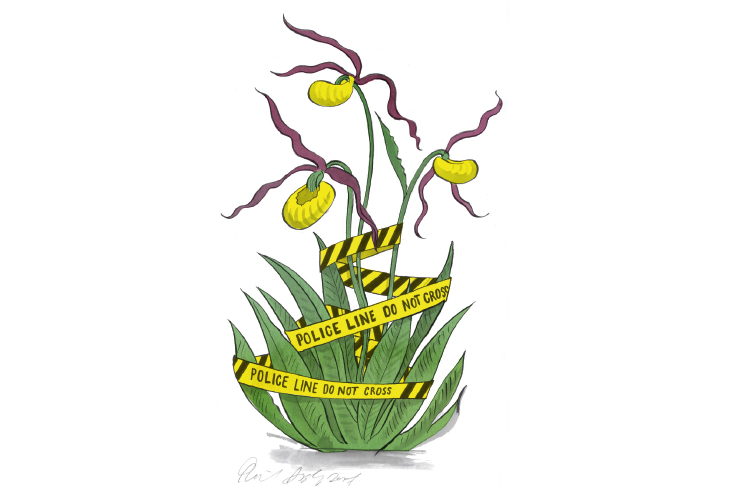The lady’s slipper orchid, Cypripedium calceolus, is both a beautiful and silly–looking plant. It is the strangest of our native orchids, with a fat yellow pouch and burgundy twisting petals. It doesn’t quite look as though it belongs in the gentle English countryside and, for a while, it didn’t belong at all. Why did I drive for two hours just to see one flower? In part because of its strange backstory. It’s not just a fabulous flower; it’s a plant that tells us about our society and the madness of all human nature.
This flower sent Victorian botanists bonkers. They were so gripped by what was known as Orchidelirium that they couldn’t stop digging up the poor Cypripedium or picking its flowers. Orchid mania meant that by 1917, the plant was declared extinct in the United Kingdom — and that would have been that, were it not for just one lady’s slipper which managed to cling on, out of sight, until the 1930s, when a botanist found it in bloom in the Yorkshire Dales.
That discovery triggered a whole new order of madness involving round-the-clock surveillance, police protection, and a secretive committee to protect the plant. Orchid maniacs crept towards it, eager to steal a cutting worth thousands of pounds. Policemen and volunteers in tents with tripwires kept guard during the flowering season. That particular native Cypripedium is still alive today, and its location is still a secret. The Cypripedium Committee are the only ones trusted with the details of where it grows; even they rarely visit.
In the 1980s, scientists at Kew Gardens set to work trying to propagate it, a struggle as orchid seeds are grumpy little things, germinating only if they’ve been picked at just the right time and with help from a special sort of rare fungi.
Eventually they cracked it. Thousands of seedlings were raised and planted out at other special secret sites across the north of England. But few of the plants made it to flower — and then they needed police protection once again.
The one place in the country where the Cypripedium has now become so widespread that it doesn’t need to be kept secret any more is the Gait Barrows nature reserve near Silverdale, Lancashire. Natural England, which runs the reserve, is so proud of the lady’s slipper that it has hammered in little signs along the route to show the way. When I found the flowers, an elderly man was prostrate like a pilgrim in front of them, snapping away, stopping only to point out to me that, like all good religious experiences, a certain amount of artifice was involved in this: scattered around the base of the plants are slug pellets. And all of the plants are protected by the sort of plastic tape you normally see strung around crime scenes. Orchids have a strange effect on the British. We’re drawn by their oddness. Some of our native orchids have evolved to resemble little white butterflies; others actually mimic insects. I recently spent two hours crawling around a meadow near Witherslack, Cumbria, to find a 15cm-high fly orchid.
The more common bee orchid has evolved not just to look like the bee it wants to attract, with a striped, velvety lip, but to smell like it too, using pheromones. There is even a very rare man orchid, though its yellow lower petals, which look like the man on traffic light crossings, are not designed to attract humans. And the lizard orchid, which has long trailing patterned petals, lures pollinators and orchid hunters in with the strong, distinctive scent of a billy goat.
Even rarer than the lady’s slipper is the ghost orchid, Epipogium aphyllum, which an amateur botanist found flowering in 2010, 23 years after it was declared extinct.
The hardest hunt I ever had was at Sandscale Haws in Cumbria, which has a population of the parasitic coral root orchid. This is such a tiny flower, hiding among the sand dunes, that I needed a National Trust warden to show me.
Why did we bother combing the dunes to find just two tiny yellow flower stalks? Why am I now planning an even longer journey to find that goat-scented lizard orchid? This grown-up treasure hunt isn’t just about the excitement of finding something rare and valuable. Orchidelirium can soothe a troubled mind — it has helped mine heal. Hunting for the flowers, peering intently at the ground as you plod along, forces you to forget yourself and all your troubles. And then the wonder of discovering a flower evolved to look just like a fly! It makes life seem worth sticking around for.
Isabel Hardman and Professor Richard Bateman discuss orchid delirium on The Spectator Podcast.
Got something to add? Join the discussion and comment below.
Get 10 issues for just $10
Subscribe to The Spectator Australia today for the next 10 magazine issues, plus full online access, for just $10.
You might disagree with half of it, but you’ll enjoy reading all of it. Try your first month for free, then just $2 a week for the remainder of your first year.















Comments
Don't miss out
Join the conversation with other Spectator Australia readers. Subscribe to leave a comment.
SUBSCRIBEAlready a subscriber? Log in